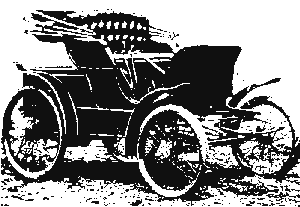|
Two men stood looking at the automobile mired in sand up to its hubcaps. One wet his pencil point on his tongue and jotted down a few words in a notebook. The other grabbed his hat from his head, threw it on the ground and stomped the daylights out of it. "Damn!," He yelled, "Seven days and five hundred miles out, then this! Look at it, Charles, buried to the running boards in this damn sand." Charles Sanders, reporter for the Cleveland Plaindealer, pulled his
spectacles off and looked helplessly at his traveling companion, Alexander
Winton, inventor of the horseless carriage. Well, some people, including
Winton, claimed he was.
 The year was 1901. They had been on the "road" for a week wrestling and cajoling the little car each long mile of the way. The trip was ballyhooed in newspapers as the first coast-to-coast trip by horseless carriage. Leaving the west coast, loaded with spare parts, gasoline, and luggage, the two headed east in the Winton toward the majestic Sierra Nevada. It was fairly easy going over bumpy dirt roads until they began traveling the two-rut wagon trails out of Sacramento that shook the little machine and rattled the teeth of its occupants. Winton and Sanders sometimes rode as the automobile chugged through choking dust or, more often, got out and pushed, onward and upward over the high mountains dividing California and the Sagebrush State. Finally, they hit the vast open spaces of Nevada and each silently prayed the trip would be easier now that the mountains were behind them. Their prayers went unanswered. Whenever the little Winton became stuck, both piled out and, using block and tackle, small tree trunks, and physical back-breaking labor liberally sprinkled with cuss words, free the machine and then continue bumping and putting along - until nature endowed them with another perplexing problem. Nine miles out of Wadsworth the valiant little automobile chugged, snorted, and gasped, but couldn't make it to the top of a sand hill. They returned to town, searched through the spare parts carried in the car, found and installed a lower gear, then back-tracked to stubbornly conquer the steep grade. Disaster struck the next day. A couple of miles out of Mill City, on the trail to Winnemucca, they tackled a wide stretch of sand. Wheels spun with no traction. The Winton's brave little 15-horsepower engine whined while tempers rose to the same temperature of the steam pouring from the radiator. Soon it was hub-deep. Sitting helplessly on top of the sand, the Winton, all 1,700 pounds of it, had become a useless piece of machinery. That's when Alexander Winton's cap was stomped to death. "By God! I know one thing." Winton uttered through clenched, gritty teeth, "It's absolutely impossible for an automobile to cross the sands of Nevada." They picked up their personal gear, took a last hopeless look at the car, then hiked to Mill City where they boarded a train home. The defeated machine was later hauled out by horse, loaded on a railroad flatcar and carried home in shame and defeat. Absolutely impossible to cross Nevada in an automobile? Just two years later an amazing feat was announced in the Elko Independent. In July 1903, a horseless carriage left Battle Mountain at 7:30 a.m. and covered 108 miles to Elko in only thirteen hours. Now, that was traveling...at 8.3 miles per hour. Nowadays, travelers motoring 75-miles an hour on Interstate 80 do not even think about the rigors of crossing Nevada at the turn-of-the-century. Most, when they pass Mill City, are unaware they are near where the first transcontinental horseless carriage journey ended in frustration on a field of sand back in 1901. 14 April 1998
|